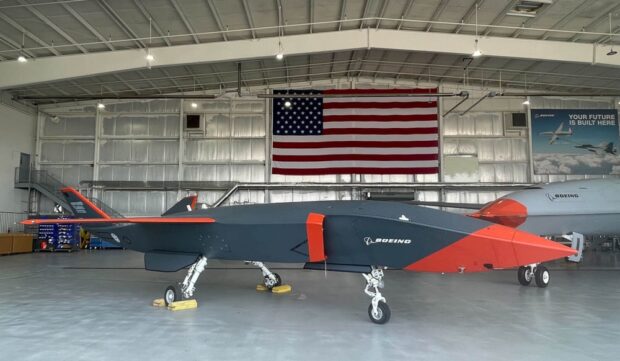Boeing revealed that its MQ-28 Ghost Bat is hanging out stateside in a first public look at the drone on US soil, months after the Air Force said it wanted to conduct flight test experiments with the loyal wingman platform.
Originally made for the Royal Australian Air Force, Breaking Defense previously reported in September that the US Air Force was “getting ready” to take possession of the drone for the service’s own testing purposes. It’s unclear whether that testing has actually begun, though the drone’s arrival at Boeing’s Phantom Works facility here outside St. Louis, which is adjacent to Scott Air Force Base, suggests that testing could begin soon if it has not already.
Krystle Carr, Boeing’s director of autonomous collaborative platforms, acknowledged the drone had arrived for testing, but didn’t say when or for whom. She declined to elaborate, and Boeing officials referred all further questions to the Air Force. A spokesperson for the service did not immediately respond to a request for comment.
The MQ-28 Ghost Bat is Boeing’s first unmanned system designed and developed in Australia, making for a curious case of an American company developing tech abroad and then exporting it back home.
According to a Boeing fact sheet, the Ghost Bat is 38 feet long, can fly “more than” 2,000 nautical miles (2,300 miles) and “uses artificial intelligence to fly independently or in support of crewed aircraft.”
The Air Force is interested in the Ghost Bat to study how drones can pair with fighter jets in combat as the service looks to field an initial fleet of 1,000 uncrewed collaborative combat aircraft (CCAs) that can fly alongside fighter jets in battle. Air Force officials say the class of drones will provide an “affordable mass” to augment the capabilities of current fighters by filling roles like missile trucks, and conducting electronic attack and surveillance.
The Ghost Bat was originally a member of the Air Force’s Skyborg program, though the drone had to withdraw since the prototypes weren’t available in time to transfer from Australia. It’s not clear how many MQ-28s currently exist.
Should Ghost Bat tests go well, Boeing would hardly be alone in the race for CCA contracts. Last week, the Air Force’s acquisition czar said that he expects as many as 30 vendors could soon be in the running to build the Air Force’s CCA fleet, with a similar number already active in fielding the platform’s underlying mission systems and autonomy technologies.
Asked whether Boeing formally planned to offer the MQ-28 for the CCA program, Pete Kunz, vice president and general manager for Boeing’s Phantom Works team, said it depends on the Air Force’s requirements, which haven’t yet been released, and whether the Ghost Bat can meet them. “We haven’t really had insight into where they’re heading yet,” he said. (Like other media, Breaking Defense accepted accommodations from Boeing for the visit.)
The Air Force is asking for $392 million in fiscal 2024 to formally kick off its CCA program.
Photo: An MQ-28 Ghost Bat unmanned aerial system sits in a hanger alongside an MQ-25 Stingray at a Boeing facility outside St. Louis on May 25, 2023 – Michael Marrow / Breaking Defense
Source: Breaking Defense

